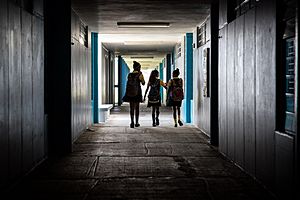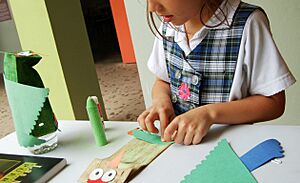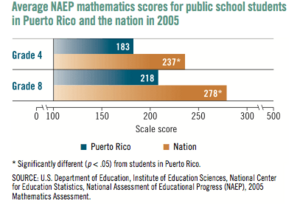Education in Puerto Rico facts for kids
| Department of Education Council on Higher Education |
|
|---|---|
| National education budget | |
| Budget | $3.5 billion US$ |
| General details | |
| Primary languages | Spanish, English |
| System type | state, private |
| Literacy | |
| Male | 96.9% |
| Female | 90.3 |
| Enrollment | |
| Total | unknown |
| Primary | 278,884 |
| Secondary | 309,420 |
| Post secondary | 283,550 |
| Attainment | |
| Secondary diploma | 60% |
| Post-secondary diploma | 18.3% |
Education in Puerto Rico is managed by the Puerto Rico Department of Education and the Puerto Rico Education Council. The Department handles all elementary and secondary public education. The Council sets academic rules and gives licenses to schools that want to open in Puerto Rico.
In Puerto Rico, it's required for kids to go to school from age five to 18. This includes elementary and high school. Students can go to either public or private schools. In 2013, there were 1,460 public schools and 764 private schools. Many students attend these schools, including over 600,000 K–12 students.
Sadly, due to damage from Hurricane Maria in 2017, a smaller population, and old buildings, many schools have closed. By 2018, 283 schools were closed.
Most people in Puerto Rico can read and write. About 93% of the population is literate.
Contents
History of Education in Puerto Rico

The very first school in Puerto Rico was called the Escuela de Gramática (Grammar School). It was started by Bishop Alonso Manso in 1513. This school was free, and students learned subjects like art, history, Latin, literature, and science.
The idea of public schools became common in 1739. An official education system was set up in 1865. Back then, going to school was required until age 9. By 1897, there were 500 public education centers.
After 1900, when the U.S. took control, a new education department was created. The first commissioner, Martin Grove Brumbaugh, helped organize the public school system. He wanted students and teachers to learn both Spanish and English. He also built a school to train teachers. These changes aimed to make Puerto Rico more like an American state.
Laws passed in 1899 made education required for ages six to eighteen. They also limited class sizes to 50 students per teacher and made schools coed (for both boys and girls).
American leaders wanted Puerto Ricans to learn how to govern themselves. They believed that by giving local governments more power, people would learn about democracy. However, in reality, the education system became more controlled by the central government.
The commissioner of education also worked to bring American culture to the island. English was the main language for teaching until 1939, when Spanish became official. Today, English is taught as a second language from first grade through high school.
Public schools became separate from religious teaching, following American ideas. Students learned U.S. history, recited the Pledge of Allegiance, and celebrated American holidays. This was meant to help locals adapt to American ways. The U.S. government built many schools and trained teachers, even sending Puerto Rican teachers to the U.S. for training.
Protestant groups from the U.S. also built schools. They spoke Spanish and supported the local Hispanic culture. Catholic schools also grew, from only three during the colonial era to many more by the 1940s.
Levels of Education
Since 2018, Puerto Rico's public school system has these levels:
| Level in Spanish | Level in English | Grades | Ages |
|---|---|---|---|
| Primario | Elementary | Pre-kindergarten (prekínder), kindergarten, and first through eighth grades | |
| Secundario | Secondary | Ninth through twelfth grades | |
| Postsecundario | Postsecondary | Thirteenth and fourteenth grades | 16+ |
Some schools, called segunda unidad (second unit) schools, teach students from kindergarten to ninth grade (K–9).
Here's another way to look at the educational levels in Puerto Rico:
| No. | Level | Age | Commonly known as | Required? | What it includes |
|---|---|---|---|---|---|
| 1 | nursery school | 0–4 | pre-K | optional | For very young children, like Early Head Start |
| 2 | preschool | 5 | K | Yes | kindergarten |
| 3 | elementary education | 6–11 | 1–6 | Yes | first grade to sixth grade |
| 4 | junior high school | 12–14 | 7–9 | Yes | seventh grade to ninth grade |
| 5 | high school | 15–17 | 10–12 | Yes | tenth grade to twelfth grade |
| 6 | undergraduate | 18+ | college | optional | Getting an associate or bachelor's degree |
| 7 | graduate | 22+ | graduate school | optional | Getting a master's or doctorate degree |
Elementary and Secondary Education

Public Education
The Constitution of Puerto Rico says that every citizen has the right to an education. So, public schools in Puerto Rico offer free and non-religious education for elementary and secondary students.
The public school system gets its money from the government and is run by the Puerto Rico Department of Education. The department has over 45,000 teachers.
Preschool programs are free for families with lower incomes. Primary and secondary education is required and free for everyone. There are over 1,400 public schools. Some public schools are known for being very good, like CIMATEC and CROEM, which focus on science, technology, and mathematics.
Public schools in Puerto Rico follow U.S. federal laws. In 2017, about 184 public schools were planned to close due to economic challenges. This meant about 27,000 students had to move to other schools.
In 2018, a new education plan was signed. It aims to give public school teachers their first raise in over ten years. This plan also introduced a system where some students can get vouchers to attend private schools or go to charter schools.
Language in Schools
Unlike most schools in the United States, public schools in Puerto Rico teach mostly in Spanish. English is taught as a second language and is a required subject at all levels.
In the early 1900s, after the U.S. took control, schools taught mostly in English. But over time, Spanish became the main language of instruction again. By the 1970s, some schools started offering programs in both languages.
Popular Culture
Some school subjects now include topics like Afro-Puerto Rican bomba, which is a type of music and dance. This helps students learn about their local culture.
Private Schools
Private schools in Puerto Rico are run by groups that are not the government. Many of them are Catholic schools. There are over 700 private schools and more than 8,000 teachers.
It's against the law to stop students from attending a private school because of their religion. Students can also choose not to join religious activities if their faith is different from the school's. Many private schools help students get into good universities in the United States.
Homeschooling
Homeschooling, which is learning at home instead of at a school, is allowed in Puerto Rico. It's not fully regulated by laws, but in 2017, Puerto Rico said that homeschooling is a basic right.
Some homeschooling parents want the government to create clear rules, while others don't want any government involvement. Sometimes, the lack of rules can cause problems, for example, when a homeschooled student was denied federal benefits because their schooling wasn't officially recognized.
Higher Education
More than half of the students who start college in Puerto Rico don't finish their degrees. About 41% of students in public universities and 33% in private ones get a diploma.
Community Colleges and Technical Schools
There are many technical schools and community colleges in Puerto Rico. These include Huertas College, Mech-Tech College, ICPR Junior College, and National University College. There's also a state-run system, the Puerto Rico Technological Institute, which offers programs at lower costs.
- Instituto de Banca y Comercio
- Ponce Paramedical College
Colleges and Universities
The three main university systems in Puerto Rico are the University of Puerto Rico (with 11 campuses), the Ana G. Méndez University System (with 3 main campuses), and the Interamerican University of Puerto Rico (with 9 campuses).
The University of Puerto Rico (UPR) is very important. It does most of the research on the island and graduates many engineers. It has the most students and teachers, and offers the most academic programs, including many advanced degrees. UPR is often seen as the best university in the Caribbean. Its main campus has won many sports championships.
The UPR system is a public university. Tuition is very affordable for students, and many low-income students can get financial help. This means most students don't graduate with college debt.
UPR offers a wide range of academic programs, including business, engineering, law, nursing, architecture, and medicine. While UPR leads in many areas, private universities are also growing and offering strong programs. For example, the Polytechnic University of Puerto Rico is known for computer security, and the University of the Sacred Heart is strong in communications.
The Interamerican University of Puerto Rico, School of Optometry is the only optometry school. The Carlos Albizu University is a leader in psychology. The Metropolitan University is known for environmental management.
In the arts, the Atlantic University College is good for digital arts. The Conservatory of Music of Puerto Rico and the Escuela de Artes Plásticas y Diseño de Puerto Rico are top schools for music and visual arts.
Most colleges and universities in Puerto Rico are accredited by the Middle States Association of Colleges and Schools. This means they meet certain quality standards.
| University | Public/Private | Locations |
|---|---|---|
| American University of Puerto Rico | Private | Bayamón, Manatí |
| Atlantic College of Puerto Rico | Private | Guaynabo |
| Caribbean University | Private | Bayamón, Carolina, Ponce, Vega Baja |
| Carlos Albizu University | Private | San Juan |
| Centro de Estudios Avanzados de Puerto Rico y el Caribe | Private | San Juan |
| Colegio Universitario de San Juan | Public | San Juan |
| Conservatorio de Música de Puerto Rico | Public | San Juan |
| Escuela de Artes Plásticas y Diseño de Puerto Rico | Public | San Juan |
| Facultad de Derecho Eugenio Maria de Hostos | Private | Mayagüez |
| National University College | Private | Arecibo, Bayamón, Caguas, Ponce, Rio Grande |
| Polytechnic University of Puerto Rico | Private | San Juan |
| Ponce School of Medicine | Private | Ponce |
| Pontífica Universidad Católica de Puerto Rico | Private | Arecibo, Coamo, Mayaguez, Ponce |
| San Juan Bautista School of Medicine | Private | Caguas |
| Seminario Evangélico de Puerto Rico | Private | Rio Piedras |
| Universidad Adventista de las Antillas | Private | Mayagüez |
| Universidad Central de Bayamón | Private | Bayamón |
| Universidad Central del Caribe | Private | Bayamón |
| Universidad de Puerto Rico | Public | Aguadilla, Arecibo, Bayamón, Carolina, Cayey, Humacao, Mayagüez, Ponce, San Juan, Utuado |
| Universidad del Este | Private | Cabo Rojo, Carolina, Manatí, Santa Isabel, Utuado, Yauco |
| Universidad del Sagrado Corazón | Private | San Juan |
| Universidad del Turabo | Private | Gurabo |
| Universidad Interamericana de Puerto Rico | Private | Aguadilla, Arecibo, Barranquitas, Bayamón, Fajardo, Guayama, Ponce, San Germán, San Juan |
| Universidad Metropolitana | Private | Aguadilla, Bayamón, Jayuya, San Juan |
| University of Phoenix | Private | Guaynabo |
Contemporary Issues in Education
Dropout Rate
A study showed that about 19.10% of all students do not finish 9th grade. In 2016, about 73.9% of students graduated from high school.
Current Educational Challenges
The government has closed many schools. From 2010 to 2018, 682 schools were closed. This means many students had to find new schools. Also, some schools don't have basic things like running water or electricity.
Closing schools helps save money, which is important for the island's economy. However, it also means that many teachers have lost their jobs. Teachers haven't received a raise since 2008, and starting teachers earn less than $2,000 a month.
Parents' Participation
In 2014, a report showed that about 55% of parents with children in public schools picked up their children's grades on time. This shows how much parents are involved in their children's education.
Student Performance in Public Schools
Studies have shown that public school students in Puerto Rico often score lower on tests compared to students in the United States. For example, in 2017, Puerto Rico ranked last in fourth-grade and eighth-grade math scores on the National Assessment of Educational Progress (NAEP) tests.
This means that many schools in Puerto Rico need to improve to meet academic standards.
Job Market for College Graduates
Many young people in Puerto Rico go to college, but there aren't enough jobs on the island for all of them. For example, in 2012, 50,000 students graduated from college, but only about 6,000 jobs were created that year that needed a college degree. This means many graduates look for jobs outside of Puerto Rico.
Notable Puerto Rico Educators
- Lolita Tizol
- Alfredo M. Aguayo
- Mariano Villaronga-Toro
- María Teresa Babín
- Elías López Sobá
- Eugenio María de Hostos
Images for kids
-
Pontifical Catholic University of Puerto Rico School of Law (PUCPR), Ave. Las Americas, Bo. Canas Urbano, Ponce, Puerto Rico
-
National University College, PR-506, Bo. Coto Laurel, Ponce, Puerto Rico
-
Parroquia Sagrado Corazón de Jesús church building (which became part of the Universidad Interamericana in 2016) is located in Santurce, Puerto Rico
-
Univ. Ana G. Méndez, Ave. Tito Castro (PR-14), Bo. Machuelo Abajo, Ponce, Puerto Rico
-
Edificio Ponce Candy Industries, Bo. Sabanetas, Ponce, Puerto Rico
-
Carlos Albizu University (San Juan Campus), Old San Juan, Puerto Rico
-
PUCPR Escuela de Arquitectura, C. Marina, Bo. Tercero, Ponce, Puerto Rico
-
Univ. Interamericana, entrada, Bo. Sabanetas, Ponce, Puerto Rico
-
Ponce Health Sciences University Research building in Barrio Playa in Ponce, Puerto Rico

















